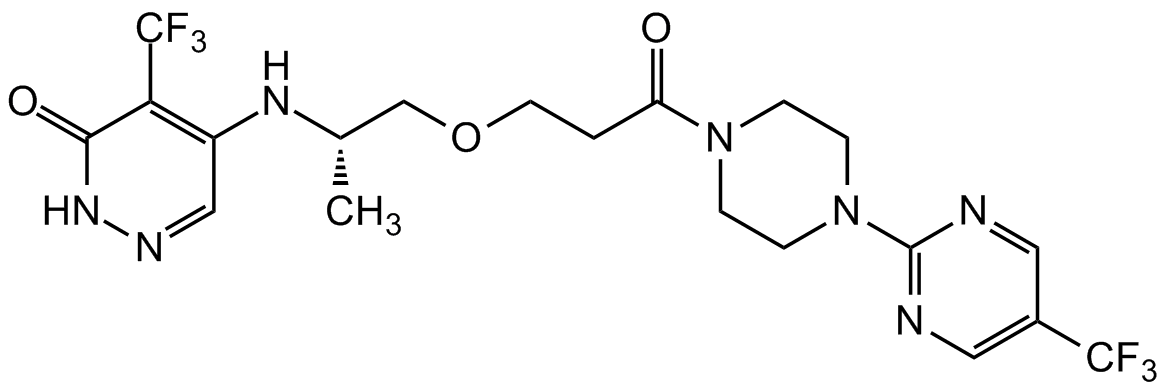RBN-2397
| Code | Size | Price |
|---|
| AG-CR1-3547-M005 | 5 mg | £130.00 |
Quantity:
| AG-CR1-3547-M025 | 25 mg | £490.00 |
Quantity:
Prices exclude any Taxes / VAT
Overview
Regulatory Status: RUO
Shipping:
AMBIENT
Storage:
Short term: +4°C. Long term: -20°C
Images
Documents
Further Information
Alternate Names/Synonyms:
Atamparib; 5-[[(1S)-1-Methyl-2-[3-oxo-3-[4-[5-(trifluoromethyl)-2-pyrimidinyl]-1-piperazinyl]propoxy]ethyl]amino]-4-(trifluoromethyl)-3(2H)-pyridazinone
Appearance:
White to off-white solid.
CAS:
2381037-82-5
EClass:
32160000
Form (Short):
solid
Handling Advice:
Keep cool and dry. Protect from moisture.
InChi:
InChI=1S/C20H23F6N7O3/c1-12(30-14-10-29-31-17(35)16(14)20(24,25)26)11-36-7-2-15(34)32-3-5-33(6-4-32)18-27-8-13(9-28-18)19(21,22)23/h8-10,12H,2-7,11H2,1H3,(H2,30,31,35)/t12-/m0/s1
InChiKey:
UQZCQKXJAXKZQH-LBPRGKRZSA-N
Long Description:
Chemical. CAS: 2381037-82-5. Formula: C20H23F6N7O3. MW: 523.4. RBN-2397 is a potent NAD+ competitive small molecule inhibitor of PARP-7. RBN-2397 selectively inhibits PARP-7 and demonstrates >50-fold selectivity for inhibition of PARP-7 over all PARP family members as measured by biochemical assays. RBN-2397 inhibits PARP-7-dependent MARylation (IC50 = 2nM) in cell biochemical assay and inhibits cells proliferation in NCI-H1373 lung cancer cells (IC50 = 20nM). By selectively inhibiting PARP-7 in tumor cells, RBN-2397 has been shown to directly inhibit cellular proliferation and restore Type I interferon signaling to stimulate an innate and adaptive antitumor immune response. Targeting cytosolic nucleic acid sensing pathways and the Type I interferon (IFN) response is an emerging therapeutic strategy being explored in oncology. The PARP family consists of seventeen enzymes that regulate fundamental biological processes including response to cellular stress. Normal cells do not express high levels of PARP-7. PARP-7 is upregulated in response to cellular stress, including exposure to toxins in cigarette smoke, steroid hormones and during viral infection. PARP-7 (TIPARP) is a monoPARP that catalyzes the transfer of single units of ADP-ribose onto substrates (MARylation) to change their function and plays a role in suppressing the Type I IFN response. PARP-7 serves as a brake in cancer cells to block the production of Type I interferons and suppress the normal cellular stress response. Thus, the expression of PARP-7 enables cancer cells to escape senescence or the loss of a cell?s ability to divide and avoid immune detection and subsequent elimination.
MDL:
MFCD32701939
Molecular Formula:
C20H23F6N7O3
Molecular Weight:
523.4
Package Type:
Vial
Product Description:
RBN-2397 is a potent NAD+ competitive small molecule inhibitor of PARP-7. RBN-2397 selectively inhibits PARP-7 and demonstrates >50-fold selectivity for inhibition of PARP-7 over all PARP family members as measured by biochemical assays. RBN-2397 inhibits PARP-7-dependent MARylation (IC50 = 2nM) in cell biochemical assay and inhibits cells proliferation in NCI-H1373 lung cancer cells (IC50 = 20nM). By selectively inhibiting PARP-7 in tumor cells, RBN-2397 has been shown to directly inhibit cellular proliferation and restore Type I interferon signaling to stimulate an innate and adaptive antitumor immune response. Targeting cytosolic nucleic acid sensing pathways and the Type I interferon (IFN) response is an emerging therapeutic strategy being explored in oncology. The PARP family consists of seventeen enzymes that regulate fundamental biological processes including response to cellular stress. Normal cells do not express high levels of PARP-7. PARP-7 is upregulated in response to cellular stress, including exposure to toxins in cigarette smoke, steroid hormones and during viral infection. PARP-7 (TIPARP) is a monoPARP that catalyzes the transfer of single units of ADP-ribose onto substrates (MARylation) to change their function and plays a role in suppressing the Type I IFN response. PARP-7 serves as a brake in cancer cells to block the production of Type I interferons and suppress the normal cellular stress response. Thus, the expression of PARP-7 enables cancer cells to escape senescence or the loss of a cell?s ability to divide and avoid immune detection and subsequent elimination.
Product Line Areas NEW:
Biochemicals, Apoptosis, Cancer, Cell Cycle, Immunology, Inflammation
Product Type:
Chemical
Purity:
>95%
SMILES:
O=C1NN=CC(N[C@@H](C)COCCC(N2CCN(C3=NC=C(C(F)(F)F)C=N3)CC2)=O)=C1C(F)(F)F
Solubility Chemicals:
Soluble in DMSO (10mg/ml) or DMF (1mg/ml). Insoluble in water.
Transportation:
Non-hazardous
UNSPSC Category:
Biochemical Reagents
UNSPSC Number:
12352200
Use & Stability:
Stable for at least 2 years after receipt when stored at -20A°C.
References
PARP7 negatively regulates the type I interferon response in cancer cells and its inhibition triggers antitumor immunity: J.M. Gozgit, et al.; Cancer Cell 39, 1214 (2021)



